|
It is difficult for a fellow to write about a gun he stands in awe of. The sixgun to which I refer is the
Ruger New Bearcat; it is an awesome little 22 revolver, and I use the word "awesome" with its original intent, not that in current use where anything even remotely approaching semi-good is called awesome.
I purchased this New Model Bearcat in the fall of 1997. That winter I spent Christmas through New Year's Day visiting with my big brother, John Taffin. We went shooting every day, using 22s only just for fun, burning up a brick or two of ammunition each time. John was also working on articles, so off to his outdoor range we went, where he "worked" while I played down the range
a ways, plinking. It dawned on me rather suddenly after I'd mowed down battalions of cans, itty-bitty little stones, and other targets of opportunity out to 50 yards, that this Bearcat could really-really shoot, and did so dead-upon its ever so tightly fixed sights.
As luck would have it, John had planned an article on Ruger's Single-Six revolvers, including a 5-1/2"
"Flat-Gate", a 6-1/2" New Model Bisley, and a 6-1/2" New Model stainless Super Single-Six. When he had finished shooting and gathering data for those three sixguns, I walked over to him and, as an afterthought, said, "You should run this Bearcat through your testing so you'll have data from Rugers in 4", 5-1/2" and 6-1/2" barrels." The Bearcat testing had hardly started when we realized it was all haywire. A re-checking of the Oehler 35P chronograph was done, with all being OK. It was during the subsequent chronograph session that we realized nothing was haywire after all; what we were seeing was a phenomenon so special it stunned both of us. The Bearcat, with its shorter 4" barrel, using the same ammunition from the same boxes, was 125 to 150 feet per second faster than the 5-1/2" and both the 6-1/2" Single-Sixes, across the board with no exceptions.
Not only did the Bearcat shoot like the finest of target pistols, it could register velocities higher than some 22 rifles! How could this particular 22 revolver give accuracy and velocity so astounding it is in a class by itself, a class where one could properly use the word "awesome"?
It started at the beginning as I was looking at Bearcats. Mark, the owner of the gun store, mentioned that he had two more
Bearcats in the back room, and asked if I would like to see them. One of those two from the back room was different from all the others, as I could feel when I thumbed the hammer back for the first time. This Bearcat's cylinder lined up dead center with the ejector rod at the "click" and would not roll backwards at all. This Bearcat also had the tightest barrel/cylinder gap you could ever want, a hammer spring noticeably heavier than the others, and a relatively light trigger with absolutely no backlash. On full-cock, the cylinder
locked tightly and perfectly aligned with the barrel, the hammer
all the way back with no extra movement, and when the hammer
fell it did so "dead", with no shock to the pistol so the sight picture
did not jar at all. The action was perfectly fitted as on a custom revolver, and the ignition system
was set-up to do its job crisply and positively with a hammer spring well strong enough to really wallop a rimfire case.
As an aside here: never, ever discount the importance of a sufficiently-heavy hammer spring in how well a gun shoots. I have seen Smith & Wesson, Colt, and Dan Wesson revolvers give weird ballistics, large standard deviations in velocities, plus ragged to lousy group sizes on target. All it took to cure each gun of its temperamental ways was a new hammer spring. This is a problem no Ruger sixguns have - what a spring!
While each factor mentioned above contributed its share to the superb performance of this New Bearcat, the factors that REALLY combine to create this kind of performance are the dimensions of the chamber and chamber throats, and the barrel groove dimensions. Along with proper timing and alignment of bore and chambers, these factors are what really determine the ultimate accuracy and ballistics.
The chambers on this Bearcat are tight; so tight that some 22 Long Rifle and 22 Short ammunition will not chamber. All the ammunition that does chamber, does so snugly and must be thumbed-in all the way. This is no big deal, as my wife can shoot this Bearcat all day without her thumb getting sore.
The cylinder throats are tighter than the chambers, and this is one modern-made 22 revolver that you can't "load" from the front of the cylinder, as often seems to be the case with
some modern 22 revolvers, none of which shoot very well at all. A tight throat from a snug chamber accepts the accelerating bullet to guide it straight through the forcing cone and into the barrel. Never underestimate the importance of these dimensions, as this is where the rubber really meets the road for every revolver ever made in the history of the world.
This Bearcat's barrel is tight, too. The first time I cleaned it I thought I had the wrong button - jag, if you prefer - on the cleaning rod. This was the first time I had encountered a barrel this tight, but it was not the last: a few months ago I purchased a new Manurhin PP22 pistol with the tightest barrel I have ever seen, and it, too, shoots like a dream. I had to trim patches to fit that PP22.
Again, you should never underestimate the importance of tight barrels delivering gilt-edged accuracy in rimfire pistols. There is no substitute for super-tight bullet fit, which is the entire premise behind
Paco Kelly's wonderful AcuRZR tool.
Another important factor for ultimate accuracy is a barrel that also has a sharp, square muzzle crown. It is important that the crown be absolutely square and even so that the bullet is perfectly released for free flight, and this New Bearcat has the most perfect crown I have ever seen on a Ruger revolver. From one end to the other, perfection!
When I bought this New Bearcat, it wore a pair of very well matched rosewood stocks. After shooting this one for a while, I realized that such a superb sixgun deserves something better, something fancier, something "Old-Timey" to honor the Ruger Bearcat's 31-caliber
Remington percussion ancestor. The OEM maker for Ruger stocks was Lett Manufacturing in New Hampshire. Bill Lett had been close friends with Bill Ruger since childhood, and Lett's had been Ruger's sixgun stock-maker from the beginning, so I decided that a nice set of Lett Sambar stags would really be at home of that wonderful Ruger. A call to Bill Lett, Jr. told me that they had no stag on-hand, but perhaps I would be pleased with a set made from ivory Micarta. So a nice set of ivory Micarta stocks graced my beloved Bearcat for a year or so, until a package arrived from Lett. It seems Bill Lett III had been on an east-coast working vacation, when in a flea market he found a piece of Sambar stag sufficient to make a single set of Bearcat stocks. They were gorgeous, they fit beautifully, and they have a wonderful feel about them that borders on the sensuous.
Lett's has since gone out of business, and it is a great shame; anyone who knows Rugers can tell you that Ruger stocks lately are not what they once were.
One final change was made to my New Bearcat. Some years ago a good friend and brother
Shootist of mine in Montana, Kelye Schlepp, called to ask if I would take some careful measurements of my Bearcat's base pin so he could add Bearcat base pins to his excellent line of Belt Mountain base pins
(www.beltmountain.com). I provided Kelye with the dimensions he needed, and bye 'n' bye a new Bearcat base pin arrived via Pony Express. This new base pin, with its "Number Five" hourglass-shaped head and smooth finish, was almost jewel-like in its blue-steel beauty. It fit the cylinder base pin hole perfectly, as well as the front and rear base pin holes in the cylinder frame. I had mis-measured where the cross-pin notch was located on the factory base pin, so the new one has about .005" fore-and-aft movement that production examples do not have. Even so, this new base pin works perfectly and looks great on the diminutive sixgun. Much to my embarrassment, Kelye had added another feature to this base pin that I hadn't even noticed until my friend and brother Shootist, Chuck Smith, pointed it out to me. Chuck was admiring my Bearcat when he suddenly stated, rather forcefully, "Jeez, Kelye never put my initials on my base pins for me!" Sure enough, right there on the front of the base pin was engraved "TM" in clean, crisp, brightly-cut steel. Well shucks, folks, who looks at the front end of a base pin
anyways...other than me, now?
As of this writing, 7455 rounds have been fired through this Bearcat. The vast majority have been 22 Long Rifle cartridges such as CCI Blazer, W-W Wildcats and PowerPoints, and Federal Bulk Pack. We have also shot up a good amount of that King of plinking cartridges, the 22 Short, including Russian Biakal International Rapid Fire, CCI Mini-Mag Shorts, and quite a few Aguila 22 Shorts from Mexico. This Bearcat loves 22 Shorts, and the little cartridges are delightful, quiet tin-can plinkers.
Finally, we arrive at the last little detail possessed by this New Bearcat, the tiny cherry on top of this wonderful package that lets me know God really smiled on this little sixgun and said, Wow, cool sixgun": it even has an even serial number!
Terry Murbach
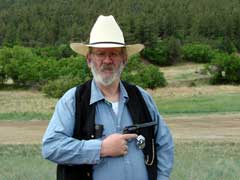
Author Terry Murbach appreciates a fine 22
sixgun; this Ruger New Bearcat is among his favorites.
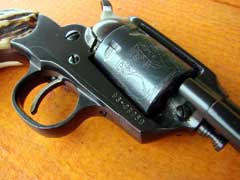
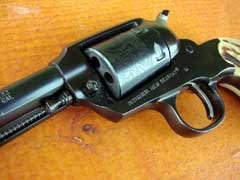
|
  
Got something to say about this article?
Want to agree (or disagree) with it? Click the following link to
go to the GUNBlast Feedback Page.
|
|
Click pictures for a larger version.
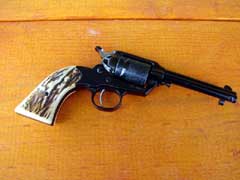

Ruger's New Bearcat, "The Sixgun God Smiled
Upon".
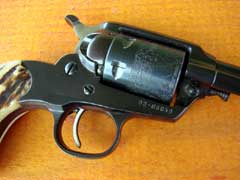
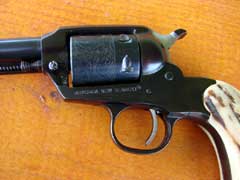
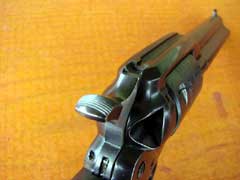
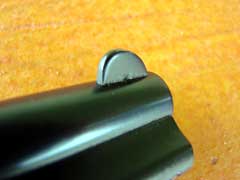

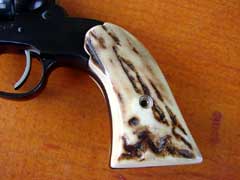
Custom Sambar stag stocks are by Lett.
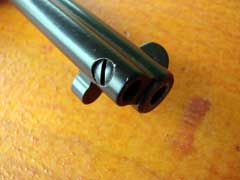
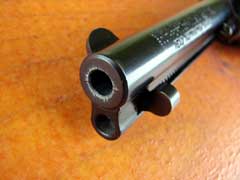

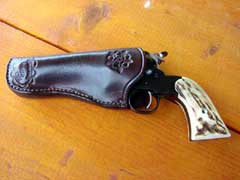
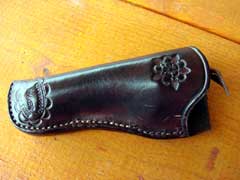

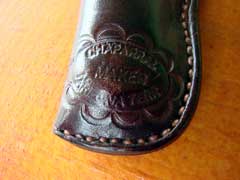
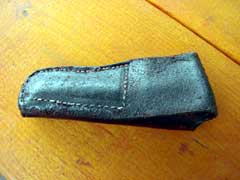
Hand-tooled and perfectly-fit holster by Chaparral
Leather.
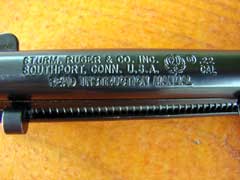
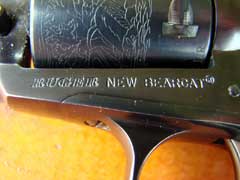
|
![]()
![]()